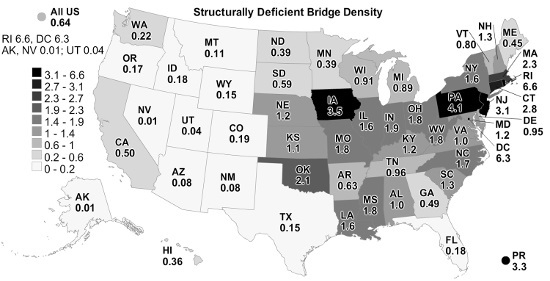Material Structural Deficiencies of Road Bridges in the U.S.
Abstract
:1. Introduction
2. Inventory Distribution
3. Structural Deficiency
4. Life Cycle
5. Distribution and Accumulation of Structural Deficiency
6. Climate Conditions
7. Discussion
8. Conclusions
Acknowledgments
Conflicts of Interest
References
- Recording and Coding Guide for the Structure Inventory and Appraisal of the Nation’s Bridges; Rep. No. FHWA-PD-96-001; Federal Highway Administration: Washington, DC, USA, 1995.
- National Bridge Inventory; Federal Highway Administration: Washington, DC, USA, 2016.
- Bridging the Gap: Restoring and Rebuilding the Nation’s Bridges; American Association of State Highway and Transportation Officials: Washington, DC, USA, 2008.
- Manual for Condition Evaluation of Bridges, 2nd ed.; American Association of State Highway and Transportation Officials: Washington, DC, USA, 1994.
- Guide Manual for Condition Evaluation and Load and Resistance Factor Rating (LRFR) of Highway Bridges; American Association of State Highway and Transportation Officials: Washington, DC, USA, 2003.
- Meeting the Needs of America’s Bridges; The Voice of Transportation, Publication Code: MNAB-1; American Association of State Highway and Transportation Officials: Washington, DC, USA, 2007.
- Our Nation’s Highways—2000; Rep. No. FHWA-PL-01-1012; Office of Highway Policy Information (OHPI); Federal Highway Administration: Washington, DC, USA, 2000.
- Status of the Nation’s Highways, Bridges, and Transit: 2002 Conditions and Performance Report; Federal Highway Administration: Washington, DC, USA, 2003. Available online: www.fhwa.dot.gov/bridge/nbi.htm (accessed on 26 March 2017).
- 2017 Bridge Report; American Road & Transportation Builders Association: Washington, DC, USA, 2017; Available online: www.artba.org/deficient-bridge-report-home/ (accessed on 26 March 2017).
- States and Outlying Areas of the United States (FIPS PUB 5-1); Federal Information Processing Standard; U.S. Government Printing Office: Washington, DC, USA, 1970.
- State Area Measurements; Geography, Reference; United States Census Bureau, U.S. Department of Commerce: Washington, DC, USA, 2010. Available online: www.census.gov/geo/reference/state-area.html (accessed on 4 January 2017).
- 2010 Census Results—United States and Puerto Rico; Geography, Maps & Data, Thematic Maps, Population Density by County; United States Census Bureau, U.S. Department of Commerce: Washington, DC, USA, 2010. Available online: www2.census.gov/geo/pdfs/maps-data/maps/thematic/us_popdensity_2010map.pdf (accessed on 4 January 2017).
- Petersen, M.D.; Moschetti, M.P.; Powers, P.M.; Mueller, C.S.; Haller, K.M.; Frankel, A.D.; Zeng, Y.; Rezaeian, S.; Harmsen, S.C.; Boyd, O.S.; et al. Documentation for the 2014 Update of the United States National Seismic Hazard Maps; Open-File Report 2014–1091; U.S. Geological Survey: Reston, VA, USA, 2014; 243p. Available online: pubs.usgs.gov/of/2014/1091/pdf/ofr2014-1091.pdf (accessed on 27 January 2017).
- LRFD Bridge Design Specifications, 7th ed.; American Association of State Highway and Transportation Officials: Washington, DC, USA, 2014.
- Farhey, D.N. Operational structural performances of bridge materials by deterioration trends. J. Perform. Constr. Facil. 2014, 28, 168–177. [Google Scholar] [CrossRef]
- Levine, D.M.; Ramsey, P.P.; Smidt, R.K. Applied Statistics for Engineers and Scientists; Pearson Higher Education: Upper Saddle River, NJ, USA, 2001; ISBN 9780134888019. [Google Scholar]
- Sweet, S.A.; Grace-Martin, K.A. Data Analysis with SPSS: A First Course in Applied Statistics, 4th ed.; Pearson Higher Education: Upper Saddle River, NJ, USA, 2012; ISBN 9780205019670. [Google Scholar]
- Farhey, D.N. Structural performances of bridge materials in the U.S. National Bridge Inventory 2013. Struct. Eng. Int. 2017, 27, 101–113. [Google Scholar] [CrossRef]
- Long-Term Bridge Performance Committee Letter Report: February 23, 2016; Long-Term Bridge Performance (LTBP) Committee, Policy Committees, Studies and Special Programs Division, Transportation Research Board, National Academies of Sciences, Engineering, and Medicine; The National Academies Press: Washington, DC, USA, 2016.
- Bilotta, R.; Bell, J.E.; Shepherd, E.; Arguez, A. Calculation and evaluation of an air-freezing index for the 1981–2010 climate normals period in the coterminous United States. J. Appl. Meteorol. Climatol. 2015, 54, 69–76. [Google Scholar] [CrossRef]
- International Energy Conservation Code (IECC); International Code Council, Inc.: Country Club Hills, IL, USA, 2015; ISBN 978-1-60983-486-9. Available online: codes.iccsafe.org/app/book/toc/2015/I-Codes/2015%20IECC%20HTML/index.html (accessed on 27 January 2017).
- Farhey, D.N. Bridge instrumentation and monitoring for structural diagnostics. Struct. Health Monit. 2005, 4, 301–318. [Google Scholar] [CrossRef]
- Wang, N.; O’Malley, C.; Ellingwood, B.R.; Zureick, A.H. Bridge rating using system reliability assessment. I: Assessment and verification by load testing. J. Bridge Eng. 2011, 16, 854–862. [Google Scholar] [CrossRef]
- Wang, N.; Ellingwood, B.R.; Zureick, A.H. Bridge rating using system reliability assessment. II: Improvements to bridge rating practices. J. Bridge Eng. 2011, 16, 863–871. [Google Scholar] [CrossRef]
- Ozer, E.; Soyoz, S. Vibration-based damage detection and seismic performance assessment of bridges. Earthq. Spectra 2015, 31, 137–157. [Google Scholar] [CrossRef]
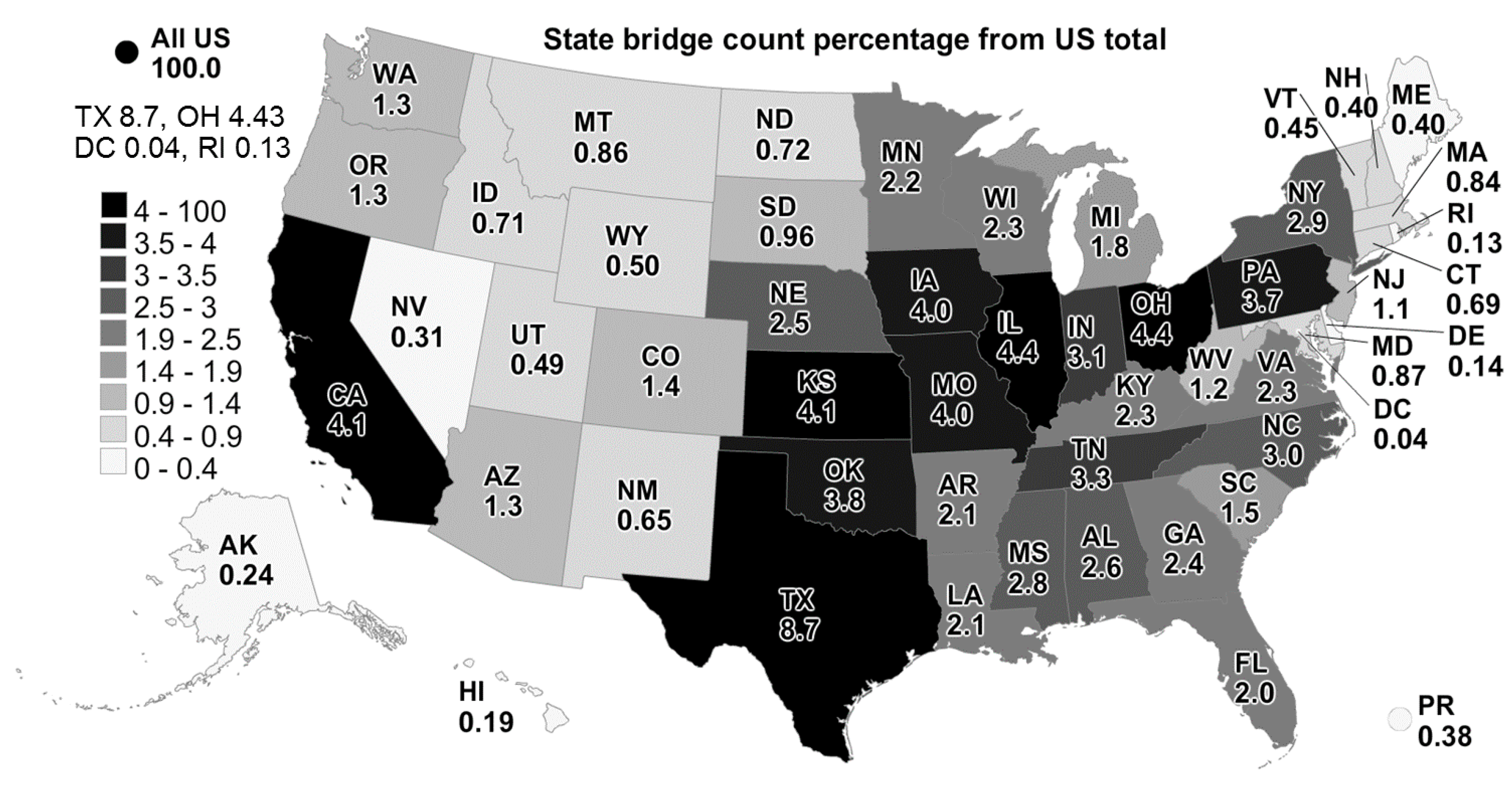
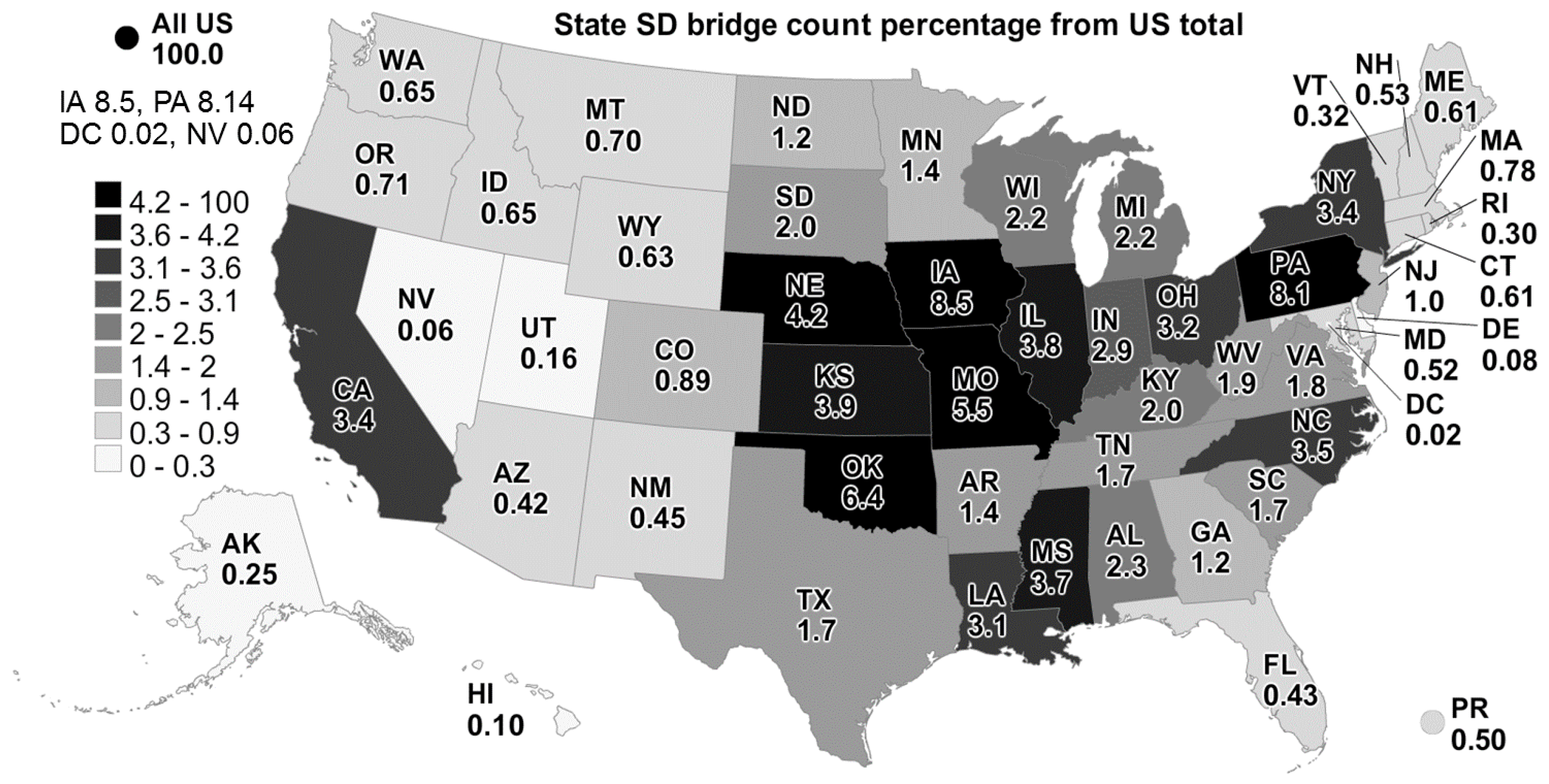


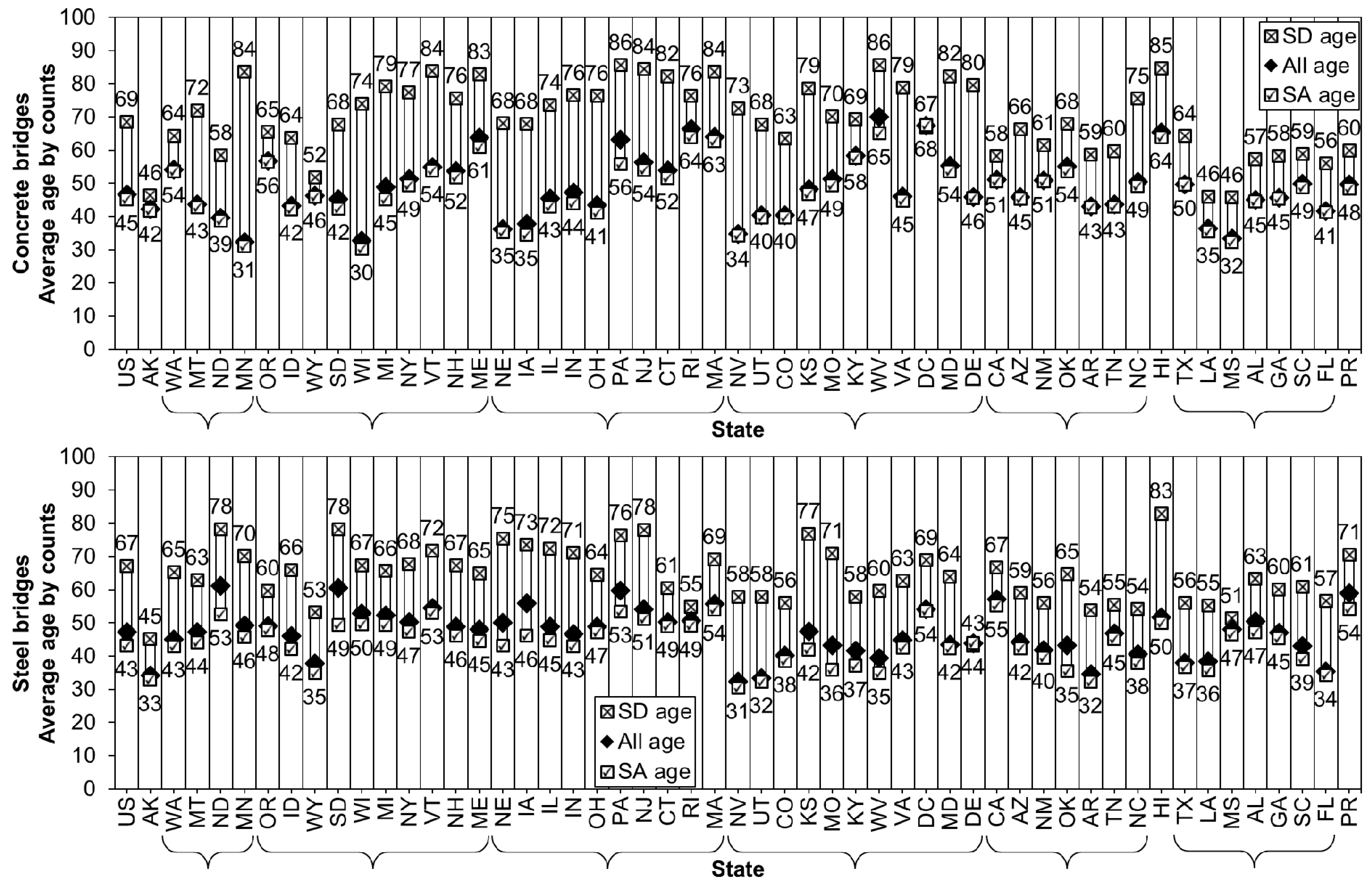
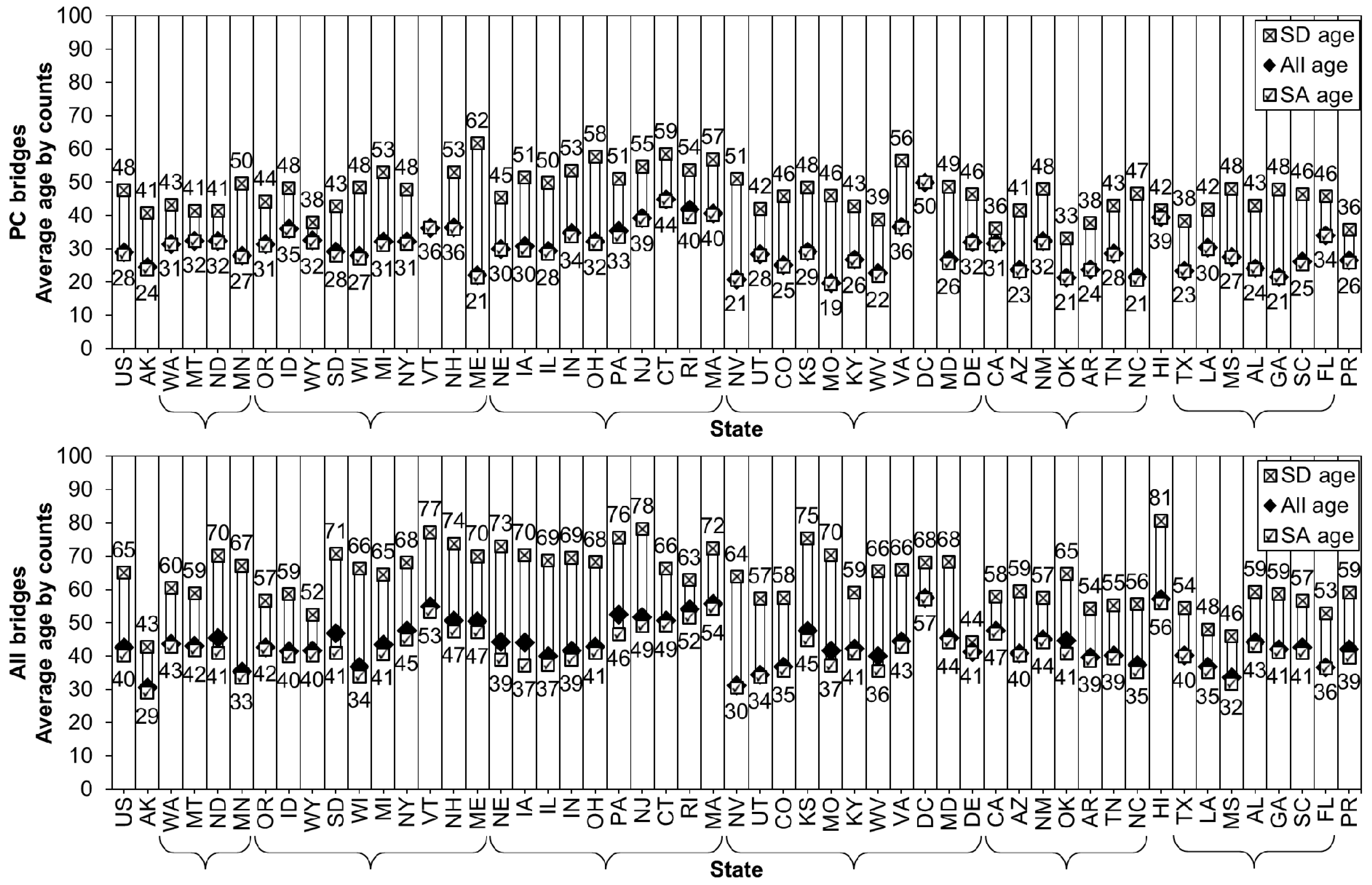



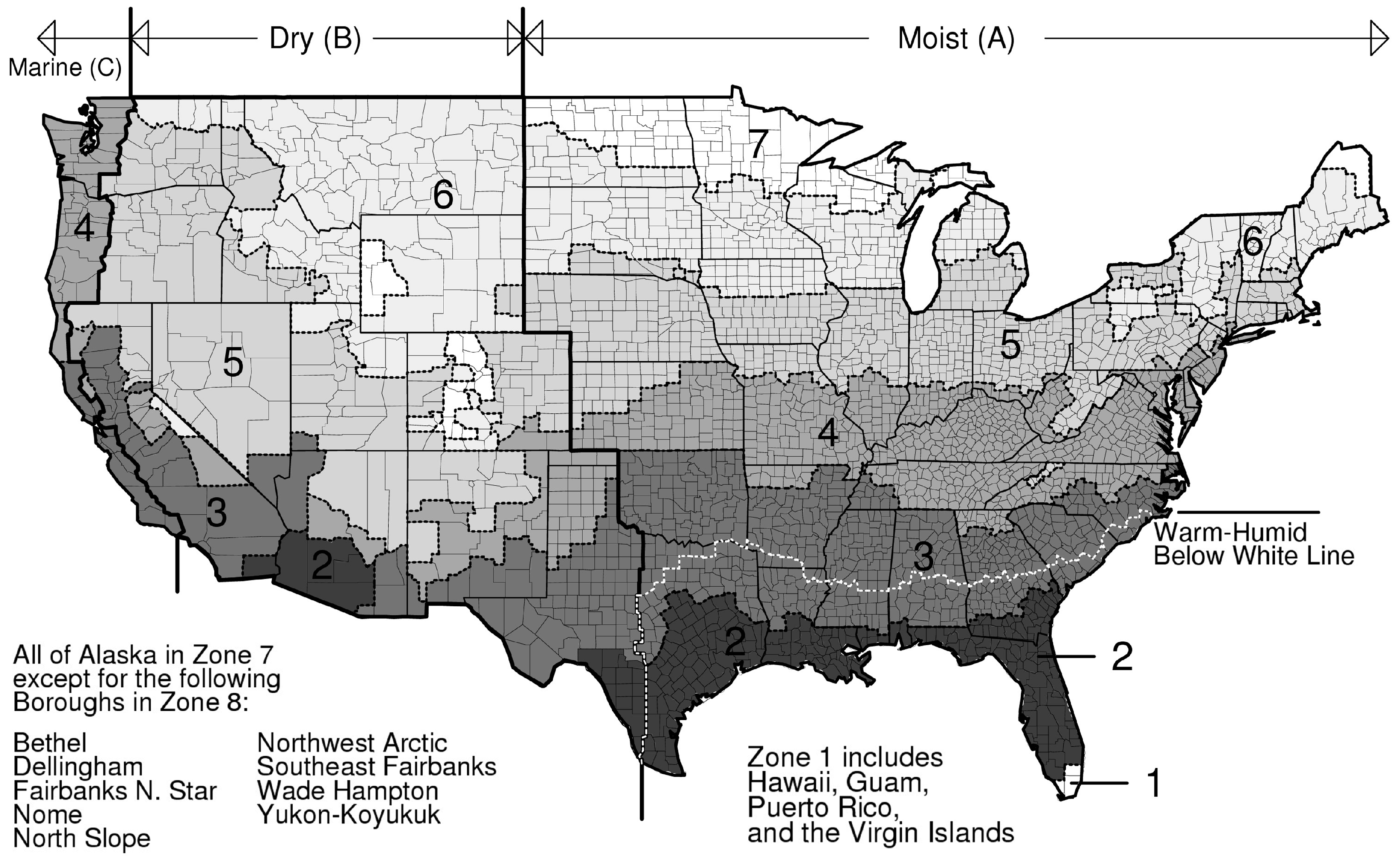
| State | # | ST | Bridge Counts | Concrete Bridge Counts | Steel Bridge Counts | PC Bridge Counts | C+S+P Bridge Counts |
|---|---|---|---|---|---|---|---|
| Alabama | 01 | AL | 16,095 | 10,614 | 2922 | 1705 | 15,241 |
| Alaska | 02 | AK | 1493 | 31 | 760 | 416 | 1207 |
| Arizona | 04 | AZ | 8056 | 5416 | 829 | 1768 | 8013 |
| Arkansas | 05 | AR | 12,853 | 7435 | 4904 | 189 | 12,528 |
| California | 06 | CA | 25,318 | 15,851 | 2787 | 5938 | 24,576 |
| Colorado | 08 | CO | 8,624 | 2693 | 2977 | 2510 | 8180 |
| Connecticut | 09 | CT | 4225 | 1015 | 2252 | 860 | 4127 |
| Delaware | 10 | DE | 875 | 229 | 403 | 179 | 811 |
| DC | 11 | DC | 254 | 66 | 163 | 24 | 253 |
| Florida | 12 | FL | 12,198 | 4334 | 1374 | 6014 | 11,722 |
| Georgia | 13 | GA | 14,790 | 8320 | 3856 | 2437 | 14,613 |
| Hawaii | 15 | HI | 1142 | 678 | 111 | 318 | 1107 |
| Idaho | 16 | ID | 4369 | 1248 | 848 | 1746 | 3842 |
| Illinois | 17 | IL | 26,674 | 8668 | 7127 | 10,741 | 26,536 |
| Indiana | 18 | IN | 19,145 | 5573 | 5172 | 7328 | 18,073 |
| Iowa | 19 | IA | 24,242 | 9316 | 8108 | 4751 | 22,175 |
| Kansas | 20 | KS | 25,047 | 14,909 | 7790 | 1320 | 24,019 |
| Kentucky | 21 | KY | 14,261 | 5724 | 2586 | 5759 | 14,069 |
| Louisiana | 22 | LA | 13,012 | 8148 | 1711 | 1665 | 11,524 |
| Maine | 23 | ME | 2431 | 747 | 1403 | 179 | 2329 |
| Maryland | 24 | MD | 5313 | 1426 | 3197 | 424 | 5047 |
| Massachusetts | 25 | MA | 5166 | 850 | 2990 | 1097 | 4937 |
| Michigan | 26 | MI | 11,086 | 1705 | 4592 | 4092 | 10,389 |
| Minnesota | 27 | MN | 13,299 | 6403 | 2380 | 3202 | 11,985 |
| Mississippi | 28 | MS | 17,057 | 9802 | 1691 | 4695 | 16,188 |
| Missouri | 29 | MO | 24,398 | 8347 | 11,288 | 4581 | 24,216 |
| Montana | 30 | MT | 5243 | 552 | 1290 | 2151 | 3993 |
| Nebraska | 31 | NE | 15,341 | 5402 | 7390 | 1536 | 14,328 |
| Nevada | 32 | NV | 1919 | 1178 | 250 | 477 | 1905 |
| New Hampshire | 33 | NH | 2470 | 710 | 1405 | 180 | 2295 |
| New Jersey | 34 | NJ | 6686 | 1219 | 3578 | 1541 | 6338 |
| New Mexico | 35 | NM | 3960 | 2109 | 593 | 1053 | 3755 |
| New York | 36 | NY | 17,457 | 3335 | 10,552 | 2859 | 16,746 |
| North Carolina | 37 | NC | 18,124 | 3730 | 8450 | 5130 | 17,310 |
| North Dakota | 38 | ND | 4401 | 1452 | 1218 | 1281 | 3951 |
| Ohio | 39 | OH | 27,100 | 7104 | 11,844 | 7835 | 26,783 |
| Oklahoma | 40 | OK | 23,049 | 9974 | 8104 | 4484 | 22,562 |
| Oregon | 41 | OR | 8037 | 2273 | 1132 | 3974 | 7379 |
| Pennsylvania | 42 | PA | 22,783 | 6705 | 7031 | 8413 | 22,149 |
| Rhode Island | 44 | RI | 766 | 186 | 392 | 154 | 732 |
| South Carolina | 45 | SC | 9344 | 5485 | 1320 | 2442 | 9247 |
| South Dakota | 46 | SD | 5866 | 2877 | 1569 | 1146 | 5592 |
| Tennessee | 47 | TN | 20,106 | 12,146 | 2558 | 5227 | 19,931 |
| Texas | 48 | TX | 53,209 | 29,237 | 7297 | 15,817 | 52,351 |
| Utah | 49 | UT | 3019 | 979 | 854 | 1078 | 2911 |
| Vermont | 50 | VT | 2749 | 793 | 1697 | 162 | 2652 |
| Virginia | 51 | VA | 13,884 | 5186 | 7071 | 1504 | 13,761 |
| Washington | 53 | WA | 8157 | 3121 | 1084 | 3427 | 7632 |
| West Virginia | 54 | WV | 7215 | 1427 | 3366 | 2287 | 7080 |
| Wisconsin | 55 | WI | 14,134 | 5924 | 3538 | 4050 | 13,512 |
| Wyoming | 56 | WY | 3085 | 1284 | 1409 | 246 | 2939 |
| Puerto Rico | 72 | PR | 2306 | 1029 | 347 | 925 | 2301 |
| United States | US | 611,833 | 254,965 | 179,560 | 153,317 | 587,842 |
| State | SD Concrete Bridge Counts | SD Steel Bridge Counts | SD PC Bridge Counts | SD Bridge Counts | Land Area (106 m2 = km2) |
|---|---|---|---|---|---|
| Alabama | 418 | 610 | 19 | 1353 | 131,171 |
| Alaska | 3 | 81 | 19 | 148 | 1,477,953 |
| Arizona | 101 | 95 | 38 | 246 | 294,207 |
| Arkansas | 180 | 518 | 3 | 845 | 134,771 |
| California | 1091 | 475 | 314 | 2009 | 403,466 |
| Colorado | 89 | 306 | 58 | 521 | 268,431 |
| Connecticut | 77 | 234 | 35 | 357 | 12,542 |
| Delaware | 2 | 38 | 3 | 48 | 5047 |
| DC | 4 | 6 | 0 | 10 | 158 |
| Florida | 100 | 69 | 34 | 251 | 138,887 |
| Georgia | 189 | 459 | 29 | 729 | 148,959 |
| Hawaii | 47 | 6 | 5 | 60 | 16,635 |
| Idaho | 61 | 138 | 89 | 385 | 214,045 |
| Illinois | 703 | 1094 | 421 | 2244 | 143,793 |
| Indiana | 566 | 673 | 416 | 1717 | 92,789 |
| Iowa | 915 | 2888 | 273 | 5025 | 144,669 |
| Kansas | 669 | 1240 | 33 | 2303 | 211,754 |
| Kentucky | 394 | 559 | 203 | 1183 | 102,269 |
| Louisiana | 696 | 232 | 79 | 1838 | 111,898 |
| Maine | 99 | 243 | 3 | 361 | 79,883 |
| Maryland | 81 | 169 | 17 | 306 | 25,142 |
| Massachusetts | 52 | 345 | 33 | 461 | 20,202 |
| Michigan | 192 | 788 | 228 | 1299 | 146,435 |
| Minnesota | 163 | 353 | 76 | 810 | 206,232 |
| Mississippi | 767 | 581 | 27 | 2184 | 121,531 |
| Missouri | 747 | 2387 | 41 | 3222 | 178,040 |
| Montana | 18 | 220 | 44 | 411 | 376,962 |
| Nebraska | 154 | 1622 | 26 | 2474 | 198,974 |
| Nevada | 13 | 17 | 2 | 35 | 284,332 |
| New Hampshire | 60 | 187 | 5 | 312 | 23,187 |
| New Jersey | 90 | 378 | 50 | 596 | 19,047 |
| New Mexico | 78 | 78 | 40 | 267 | 314,161 |
| New York | 231 | 1558 | 133 | 1990 | 122,057 |
| North Carolina | 177 | 1418 | 201 | 2085 | 125,920 |
| North Dakota | 65 | 406 | 47 | 692 | 178,711 |
| Ohio | 464 | 1189 | 167 | 1893 | 105,829 |
| Oklahoma | 1058 | 2186 | 133 | 3776 | 177,660 |
| Oregon | 105 | 113 | 96 | 417 | 248,608 |
| Pennsylvania | 1618 | 1934 | 981 | 4783 | 115,883 |
| Rhode Island | 37 | 101 | 25 | 178 | 2678 |
| South Carolina | 585 | 238 | 109 | 1004 | 77,857 |
| South Dakota | 316 | 611 | 96 | 1156 | 196,350 |
| Tennessee | 419 | 431 | 110 | 1026 | 106,798 |
| Texas | 242 | 510 | 32 | 1008 | 676,587 |
| Utah | 27 | 34 | 17 | 95 | 212,818 |
| Vermont | 32 | 134 | 0 | 190 | 23,871 |
| Virginia | 215 | 808 | 27 | 1063 | 102,279 |
| Washington | 165 | 97 | 56 | 385 | 172,119 |
| West Virginia | 338 | 606 | 119 | 1092 | 62,259 |
| Wisconsin | 354 | 678 | 178 | 1282 | 140,268 |
| Wyoming | 91 | 225 | 27 | 370 | 251,470 |
| Puerto Rico | 132 | 102 | 60 | 296 | 8868 |
| United States | 15,490 | 30,468 | 5277 | 58,791 | 9,156,461 |
© 2018 by the author. Licensee MDPI, Basel, Switzerland. This article is an open access article distributed under the terms and conditions of the Creative Commons Attribution (CC BY) license (http://creativecommons.org/licenses/by/4.0/).
Share and Cite
Farhey, D.N. Material Structural Deficiencies of Road Bridges in the U.S. Infrastructures 2018, 3, 2. https://doi.org/10.3390/infrastructures3010002
Farhey DN. Material Structural Deficiencies of Road Bridges in the U.S. Infrastructures. 2018; 3(1):2. https://doi.org/10.3390/infrastructures3010002
Chicago/Turabian StyleFarhey, Daniel N. 2018. "Material Structural Deficiencies of Road Bridges in the U.S." Infrastructures 3, no. 1: 2. https://doi.org/10.3390/infrastructures3010002
APA StyleFarhey, D. N. (2018). Material Structural Deficiencies of Road Bridges in the U.S. Infrastructures, 3(1), 2. https://doi.org/10.3390/infrastructures3010002




